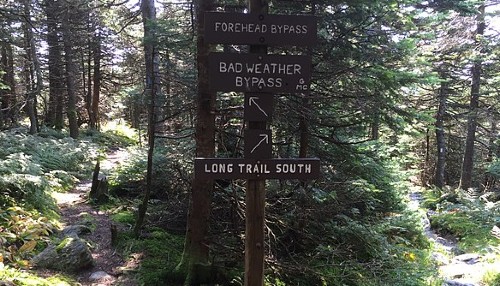After a length of hiking through the trail, Alden’s blood sugar dropped too low. He passed out and began to suffer a seizure. Thankfully, a fellow hiker was nearby who just happened to be an EMT. The EMT rushed to Alden to deliver aid. After Alden regained consciousness, the EMT decided that further aid was going to be needed. They needed a rescue.
Unfortunately, one of the chief qualities that adds to the appeal of the Long Trail – *its remoteness – also meant having zero cell reception throughout many parts of it. That’s precisely what Alden and the EMT realized as they tried to call for help.
*Long Trail is one of the most remote hiking experiences in America.
But Alden had an ace up his sleeve: he was a ham radio operator.
And it just so happened that Alden had brought along his HT (handy-talky) radio with him. Alden’s radio was a Baofeng – easily the most hated radio brand amongst serious ham radio aficionados out there. In a disaster situation, though, Alden proved that even something as scorned as a Baofeng could save lives. Alden tuned in to a local repeater on Mt. Greylock, where he put out a call for a rescue. Two men, Ron Wonderlick and Matthew Sacco, were sitting at home listening to the radio traffic on the local repeater that day and heard Alden’s call for help.
After a brief discussion between Matthew and Ron, Matthew decided to go mobile. He grabbed his radio gear, jumped in his vehicle, and drove off to the parking lot of the Long Trail (after contacting emergency services). Matthew met the Incident Command Leader for the SAR operation at the parking lot, offering his services as a radio operator to help. The rescue operation agreed. Matthew first attempted to contact the Mt. Greylock repeater that Alden had used initially to make his call for help.
Time to get creative.
Getting a hold of the repeater was tricky, and Matthew knew if he couldn’t reach it, the rescue operation would only have a much more difficult time. He initially tried his HT unit.
It didn’t work.
Then Matthew tried the mobile radio he had attached inside his vehicle. Mobile rigs have better power and range than an HT (they’re hooked up to a car battery after all), and Matthew stood a good chance to contact the repeater with such.
However, that didn’t work either.
Then, Matthew had to get creative. Grabbing his “radio bag,” he quickly constructed a J-pole antenna, attached it to his HT, and grabbed his fishing pole out of his vehicle as well. A heavy sinker was attached to the fishing pole. Matthew used that to cast his line up and over a tree branch 20′ in the air. From there, he attached his J-pole antenna to the line, reeling it up high into the air. Antenna height is paramount to reaching far-away repeaters. After Matthew connected his HT to this new jerry-rigged setup, he could access the Mt. Greylock repeater. The SAR operation now had outside comms established.
Now, they just had to find Alden.
An ATV would not be able to drive out along the Trail, so the only option rescuers had was to fly in a chopper. The Mt. Greylock repeater was used to communicate with the New York State Search and Rescue team as they flew a helicopter to Alden’s location.
It wasn’t long until yet another hiccup was introduced into the mix, however. The SAR team couldn’t reach the helicopter with their radios. Why? Because they were using the stock “rubber duck” antennas that came with their radios – a type of antenna notorious for having poor range.
At this point, Alden’s Baofeng was able to assist yet again. He upgraded his antenna with an after-market version and lent his radio to the rescuers (it’s unclear if some of them were already at the scene). Whether they were or not, Alden’s radio was able to establish proper comms with the helicopter, the chopper arrived on site, and Alden was pulled out and brought to safety.
What can preppers learn from all this?
Baofeng radios are regularly referred to as trash. While I most certainly agree there are better options out there, you use what you have. If all you can afford is a Baofeng, then get the Baofeng. A $200 Savage Arms shotgun can save a life as easily as a $1500 Mossberg. What I am trying to say is the preps one can afford are the ones that save lives. Not the ones that are still sitting up on the store shelves for “someday”.
As a prepper, I believe there are several lessons we can learn from this story. There are so many aspects to this entire rescue operation that one could easily spend a lot of time sifting through the nuggets of wisdom. However, below are what I believe to be some significant points.
Here are some amazing tips from Daisy on spending cuts you can make so you can afford your preps!
Get your post-disaster comms in order and know how to use your equipment!
First and foremost, the prepper should be able to see that post-disaster comms ability truly does matter. In this case, it very well may have saved Alden’s life. If there’s a power outage in your area or if your phone dies or has no coverage, will you have the capability to call for help should you need it?
If you’re not familiar with the world of ham radio, Baofeng models are notoriously difficult to learn. While it’s not clear which model Baofeng Alden was using, I think it’s a good bet to say he was probably using the UV-5R. The UV-5R is the de facto prepper radio, and at $25, these things are everywhere.
Whatever model Alden was using, though, he clearly knew how to use his equipment. Had he not, this story could have very easily ended differently. Shoot, even Matthew exhibited this trait by making an impromptu antenna using a fishing pole. That is knowing your gear. Don’t just buy gear and throw it in a wall locker in your basement. Train with the gear you have. Use it and abuse it as you become well-versed in the equipment. Post-disaster is no time to train. It’s a time to do.
Prepare ahead of time for bug-out situations.
While this may be the low-hanging fruit here, it’s worth pointing out. Prepare ahead of time for BOB situations – of which backpacking is a perfect example. Alden had clearly done some of this already by knowing the frequency to reach local repeaters along his route and by his foresight in packing a ham radio with him.
Don’t forget about the importance of packing food in your BOB. As a backpacker myself, I can attest to the fact that trekking with 40 pounds of gear on your back (if not more) will sap you fast. You have to be refueling your body with both food and water constantly. You will not be in the right frame of mind if you don’t have plenty of those two items with you. So, stuff as many MREs in your bag as you can. Bring two types of water purification systems with you and plenty of water.
You’re going to need them.
What’s in your bag? Check out Fabian’s pdf book, “The Ultimate Survival Gear Handbook.” For only $5.49 this 148-page handbook is the ultimate guide to the kits that will keep you alive.
Going off air: Are you prepared?
We can learn a lot from this story, and I hope you take some of its lessons to heart. Post-disaster comms are a vital prep to have at the ready. Sure, it may not be as immediately essential as an adequately stocked larder full of food and water for your family. However, you are going to need the ability to communicate with others post-disaster. And a ham radio is a fantastic way of doing so.
Does anybody else think the concept of a “radio bag” is awesome? Do we have any ham radio operators out there? How about someone with a Baofeng? Share your knowledge with us and the other readers in the comments section.
Author
Aden Tate has a master’s in public health and is a regular contributor to PewPewTactical.com, SurvivalBlog.com, SHTFBlog.com, ApartmentPrepper.com, HomesteadAndPrepper.com, and PrepperPress.com. Along with being a freelance writer he also works part-time as a locksmith. Aden has an LLC for his micro-farm where he raises dairy goats, a pig, honeybees, meat chickens, laying chickens, tomatoes, mushrooms, and greens. Aden has two published books, The Faithful Prepper and Zombie Choices. You can find his podcast The Last American at Preppers’ Broadcasting Network.




